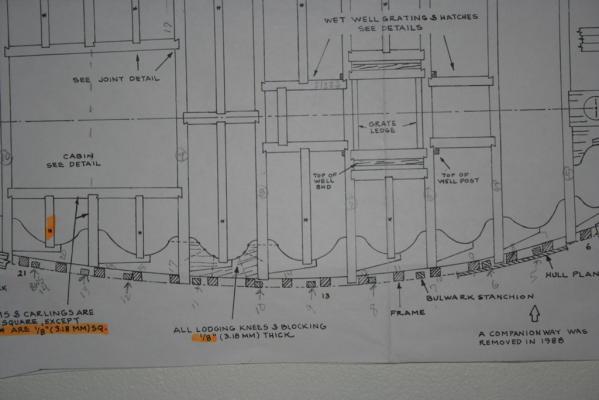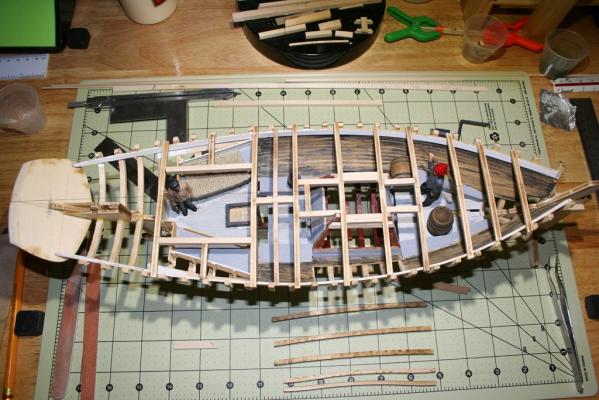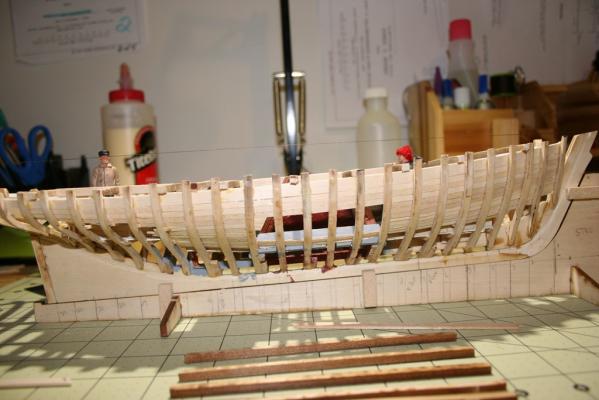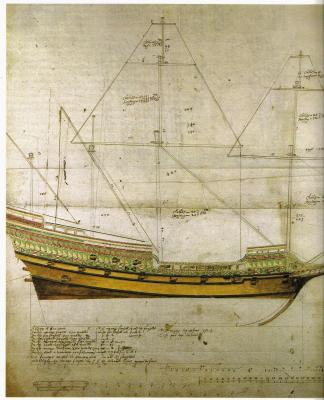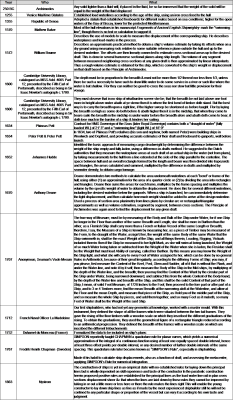-
Posts
3,156 -
Joined
-
Last visited
Content Type
Profiles
Forums
Gallery
Events
Everything posted by trippwj
-
Thanks, Augie - moving forward, keeping spirits up. Gotta be something better just over the horizon! Thank you, Lawrence. She is certainly no match for your Annie, but she is a fun build! Thanks, David. Got a dusting of snow last night and again this morning, but the snow is slowly but surely melting. Only 30 inches or so (on average) left to go! Thank you, Grant. It was tough to get motivated, but moving along now. Reorganized the shop today, cleaning out my old office to convert into a bedroom.
-
Superlatives fail me, Denis. You will need a small bottle of bubbly to christen this beauty- she looks so real! Well, sir, as Bob's your Uncle I am looking forward to the next steps - are you weaving your own nets?
- 956 replies
-
- andrea gail
- trawler
-
(and 1 more)
Tagged with:
-
Greetings - and please accept my apology for the lengthy delay between posts! Between the snow onslaught in January and February and then my employment change last month, well, it has been rather difficult to get motivated to spend time in the build yard. Most of the progress shown was from January. I am trying to get my enthusiasm back to move on with Emma and hope to be splitting time between a side research project, the job search and the build table. At any rate, the deck beams are nearly all in - 3 more major beams and a few cross pieces to add. I have opted not to do the knees - I tried a couple of times but they did not come out well at all. View from above Profile view. Note the very low clearance in the forward hold! The cabin will have a overall height just above the worker standing there. Next up is install the last few deck beams and then start planking. Suggestions desired - and thanks for stopping by!
-
While it is a British treatise, this may be of some use to you. A Manuscript on Shipbuilding, Circa 1600, Copied by Newton Transcribed by Richard Barker in The Mariner’s Mirror, 80, 16–29, doi:10.1080/00253359.1994.10656481. http://dx.doi.org/10.1080/00253359.1994.10656481(Accessed February 16, 2015). The document presented here came to light as a result of an item in M.M., 40 (1954), 73, one of an occasional series of lists of Records. Thanks are due to the Librarian of the Cambridge University Library for permission to publish the text. It is catalogued as MSS Add. 4005 Part 12, presented by the Fifth Earl of Portsmouth, described as being in Sir Isaac Newton's autograph c.1700. The description masks what this writer was delighted to discover, in an idle moment: that the manuscript is a copy of one or possibly two earlier documents, parts of which clearly date from about 1600. The section of this manuscript on proportions of masts and yards is manifestly (and almost verbatim) the same as the Scott Manuscript (RINA No. 798). Otherwise the general style and content of these two manuscripts are broadly similar, in respect of the processes of moulding, for example, but in no sense are they direct copies. In fact this new manuscript contains a more coherent description of some details of ship construction than can be found in the Scott MS.
-
Awesome looking work, popeye! Enjoying the build whilst lurking on the sidelines.
- 956 replies
-
- andrea gail
- trawler
-
(and 1 more)
Tagged with:
-
Abe books has a copy listed for $50 at http://www.abebooks.com/RIGGING-WEST-COAST-BARKENTINES-SCHOONERS-TOM/6468957438/bd
-
The picture below is used on many websites discussing Mathew Baker and the Revenge of 1570. Can anyone point me to the original source for the picture? THANKS!
-
Jay - Not sure if this will help, but here is how Humphreys describes the floors and futtocks in his 6/19/1794 list to the War Department: Floor & raising timbers of good white oak sided 12 ½ inches moulded at the floor surmark 15 inches & in the throat from the top of the deadwood 21 inches to be bolted through the keel with one & 3/8 inch bolts. Those bolts should be put as near the side as possible of the keel in order to give room on the other side for the keelson bolts, one floor bolted near the larboard side of the keel, the other on the starboard side. The timber all to be double bolted from the foremast to within 10 feet of the mizzen mast. Lower futhooks of live oak sided 12 inches in the midships & something smaller at the fore & aft ends of the ship to butt against the side of the deadwood amidships to have cross chocks fayed on the deadwood & their heels to be bolted through the keelson & keel with 1 1/8 inch bolts. Middle & upper futhooks & top timbers Sided 11 ½ inches. Top timbers moulded a the gun whale 7 inches at the port sill 9 inches all the other timber sized by diminishing line from the port sill to the floor surmark which is 15 inches. Timbers framed floor timbers, lower futhook, middle & upper and top timbers all to be framed in frames and bolted with 3 bolts 1 ½ inch square in each scarph except the lower futhooks and floor which should have 1 ¼ inch bolts the timber must be pieced fair & true for if they are not out of winding it will be impossible to level the timber with any truth. He describes the gunports thusly (dimensions are feet-inches): Height of port sills of the quarter deck & forecastle 1 – 10 Height of ports on gundecks 2 – 4 In the clear up & down 2 – 11 Fore and aft 3 – 5 Distance between ports 7 – 5 After port aft side before the rabbet of post 6 – 4 Fifteen ports on each side besides the bridle or bow port, if any The attachment describes the alterations in the frames to accommodate the gun ports. 1795-11-16 WD to Constr CIRCULAR_ZXA06.138-143.pdf
- 572 replies
-
- constitution
- frigate
-
(and 1 more)
Tagged with:
-
Don - it is called The Ships of Abel Tasman by Ab Hoving and Cor Emke. Published in 2000, ISBN 9789065500878. I could not find any on Amazon, but I did find one on Abe Books http://www.abebooks.com/servlet/BookDetailsPL?bi=14953170974&searchurl=tn%3DThe+ships+of+Abel+Tasman+With+an+introduction+by+Peter+Sigmond%26an%3DHOVING%2C+Ab+ I also find it on the publisher's website here: http://www.verloren.nl/boeken/2086/253/168/maritiem-en-waterstaat/the-ships-of-abel-tasman Hope that helps!
-
Matti - Have you looked at 17th Century Dutch Merchant Ships: Text, Photos and Plans for the Ship Modeler by Ab Hoving (2014). SeaWatch Books, Florence, OR, 152 pp. http://www.seawatchbooks.com/114003? It is reviewed here (with pictures): http://modelshipworld.com/index.php/topic/8853-17th-century-dutch-merchant-ships/?p=262024 It is a wonderful reference, primarily 17th century, but may provide you with some backwards looking ideas. The plans include the following: Seagoing Vessels: Pinas Witsen – scale 1-96 – 4 sheets of plans. Fluit “Langewijk” – scale 1-96 – 3 sheets of plans. Fluit “Zeehaen” (Able Tasman) – scale 1-96 – 3 sheets of plans. Fluit “Roode Leeuw” – scale 1-96 – 2 sheets of plans. Cat “Peacock” – scale 1-96 – 1 sheet of plans. Coastal Trade: Boyer 86ft – scale 1-48 – 3 sheets of plans. Galliot – scale 1-48 – 2 sheets of plans. Inshore: The Narrow- & Wide-ship – scale 1-48 – 2 sheets of plans. Kaag – scale- 1-48 – 1 sheet of plans. Fishermen as Traders: Buss 1598 – scale 1-96 – 1 sheets of plans. Hooker – scale 1-96 – 1 sheets of plans. Pink – scale 1-48 – 1 sheet of plans.
-
That wouldn't necessarily be that large a volume - if in bags, would take up a total of about 130 cubic meters. Sounds like a huge volume, but if packed in bags around other barrels &c. it isn't so bad. If in barrels, well, then it is a bigger space hog. A flour barrel held about 196 pounds in the early 19th century, so to store 70 tons (assuming a long ton of 2,240 pounds), then would require some 800 barrels spread across the 2 ships. That is a LOT of barrels!
- 346 replies
-
- terror
- polar exploration
-
(and 2 more)
Tagged with:
-
I like the looks of that, Matti. Here is something to mull over when looking at tonnage figures from modern writers. The size of the Hanseatic and Dutch ships which plied the Baltic was also for a long time expressed by estimates of how much grain they could carry. The Hanseatic grain measure, the last, was a volumetric unit which had an equivalent in pounds, like the early English ton. Last meant at first the load of a four-wheeled wagon. When it was somewhat more precisely defined, the standards set varied from port to port and within the same port for different commodities. In Danzig, for example, 3 lasts of herring equaled 4 lasts of rye, and the last of rye, equal to 3.105 cu. m. or 2,257 kg. (4,975 lbs.), was used to rate ships. At Hamburg in the seventeenth century the grain last was 3.159 cu. m. (111.5 cu. ft.), but for rating ships there was a special Schiffslast equal to 2,000 Hamburg pounds (1,935 kg. 4,266.9 lbs. Eng.). At Amsterdam, grain was measured using the Kornlast of Danzig of 3.105 cu. m. or 109.6 cu. ft. but ships were rated according to the weight they could carry in a Schiffslasten of 2,000 Amsterdam pounds (1,976kg. or 4,356.3 lbs.). This situation seems to be the result of a shift away from an ambivalent measure, which expressed a rough equivalence of volume with weight, towards two distinct measures: the Kornlast which measured volume and the Schiffslast which told how much a vessel could carry without submerging its loadline excessively. Generalizing roughly, we can say that the Hanseatic and Dutch Schififslast equalled about 4,480 lbs. (2,032 kg.) and that the Kornlast became by the seventeenth century a measure of volume equal to about 112 cu.. ft. (3.2 cu.. M.). A ship's capacity in the two lasts was the same when the specific gravity of the cargo was roughly .63. SOURCE: Lane, F. C., 1964: Tonnages, Medieval and Modern. The Economic History Review, 17, 213–233, doi:10.2307/2593003. http://www.jstor.org/stable/2593003(Accessed January 25, 2015).
-
If one considers that the average British seaman was, until the middle of the 19th century, rather poorly paid (in earlier times, not paid until he was released from the ship, which may have been years), often poorly equipped when enlisted, and had to acquire apparel through the ships slops locker (his pay would be reduced based on the slops received), there was a decided self interest in protecting the footwear - not wearing it out by wearing the shoes/boots at all times. In particularly colder climates, there was an obvious need to wear something. In the rigging, however, there are so many accounts (logs, diaries, tales and so on) from contemporary sources that there was a decided preference for bare feet when aloft for better footing and grip. Remember, period shoes/boots that the sailor may have been issued were far from what we have today.
-

Seeking information on determining load waterline
trippwj replied to trippwj's topic in Nautical/Naval History
So, to summarize key data thus far, I present this lovely chronological table. Still a work in progress so no firm conclusions - please let me know if I have missed something germane (which is highly probable....) -
For ships of the 16th century, it was not a common practice to determine the displacement before the vessel was launched. Indeed, it was not common to determine displacement after launch. The common system of measurement used provided an estimate of the burthen or capacity based on volume - tuns (volumetric) was the general unit of measure. The Dutch and Swedes were somewhat ahead of others in utilizing science to determine the displacement (tons or tonnes - a weight based on volume of water displaced), and in the late 16th century Mathew Baker was apparently using similar methods for his designs, but the calculation of displacement did not come into common practice in most countries until the 18th century. For a very thorough discussion, see Ferreiro, L., 2007: Ships and science the birth of naval architecture in the scientific revolution, 1600-1800. MIT Press, Cambridge, Mass., http://search.ebscohost.com/login.aspx?direct=true&scope=site&db=nlebk&db=nlabk&AN=173439(Accessed February 8, 2015). If you do not have the book, his thesis that the book is based upon can be found at Ferreiro, L., 2004: Down from the mountain : the birth of naval architecture in the scientific revolution, 1600-1800. University of London, 550 pp. http://ethos.bl.uk/OrderDetails.do?uin=uk.bl.ethos.411610(Accessed March 2, 2015). If you can read it, there is a Dutch treatise that may be worth accessing from 1671 - Witsen, N., 1671: Aeloude en hedendaegsche scheeps-bouw en bestier. t’ Amsterdam : By Casparus Commelijn, Broer en Jan Appelaer, Boeck-verkoopers, 813 pp. http://archive.org/details/gri_33125008247716(Accessed March 9, 2015).
-

Constellation hammock cranes and color scheme.
trippwj replied to Jparsley's topic in Nautical/Naval History
Here's the link tot he 1797 Constellation info on Wiki - http://en.wikipedia.org/wiki/USS_Constellation_%281797%29 There are some paintings (none contemporary that I could see) available at http://www.navsource.org/archives/09/46/46020.htm The first 4 would be of the original frigate while the rest are of the new one built 1854. I suspect that there were hammock rails of some sort - you may be able to glean some information from the Constitution history. Note that the Navy History and Heritage Command did the miserable trick of redesigning their website late last year and most links to it do not work. It is also very difficult to find anything there now. -

Constellation hammock cranes and color scheme.
trippwj replied to Jparsley's topic in Nautical/Naval History
Welcome, kind sir! As you note, the Constellation in Baltimore is a mid-19th century replacement of the original. You may want to look into a couple of rather detailed volumes out there that discuss her history - may I suggest the following for a starting point for your research? Chapelle, H. I., and L. D. Polland, 1970: The Constellation Question. Smithsonian Institution Press, Washington. Ferguson, E. S., 1956: Truxtun of the Constellation; the life of Commodore Thomas Truxtun, U.S. Navy, 1755-1822. Johns Hopkins Press, Baltimore, 322 p. pp. http://catalog.hathitrust.org/Record/000334060(Accessed September 14, 2014). Toll, I. W., 2006: Six Frigates: The Epic History of the Founding of the U.S. Navy. 1ST edition. W. W. Norton, New York, 560 pp. ISBN 9780393058475 http://www.navsea.navy.mil/nswc/carderock/pub/cnsm/faq/faq_13.aspx -
Steve (assuming that is the name) - How'd I get here? I started building wooden ship models just over 3 years ago (wow - has it been that long?), and started to gather books and downloadable documents as part of my learning. I found that the research process itself was very satisfying for me - goes back to my education in Marine Biology, I guess - and took on a life of its own. I have two major research endeavors I am engaged in at the moment - one related to the early US Navy (drawing heavily on the Papers of the War Department website – the wife is doing all the transcription) and the other around the pre-determination of waterlines (which led to many of the archeological references). For Mesopotamia, you could start with the thesis listed above and then move through the references cited. I am not familiar with the era (was looking at it for a different purpose) but, in general, a thesis will provide some solid leads. As for Egyptian vessels, there is some better information out there (based on a quick look) that may also guide you along the right path. Here are a couple for starters. Belov, A., 2014: A New Type of Construction Evidenced by Ship 17 of Thonis-Heracleion. International Journal of Nautical Archaeology, 43, 314–329, doi:10.1111/1095-9270.12060. http://onlinelibrary.wiley.com/doi/10.1111/1095-9270.12060/abstract(Accessed March 5, 2015). Geanette, M., 1983: Mast Step and Keelson: The Early Development of a Shipbuilding Technology. Texas A&M University, http://nautarch.tamu.edu/Theses/pdf-files/Geannette-MA1983.pdf(Accessed March 19, 2015). Monroe, C., 1990: The Boatbuilding Industry of New Kingdom Egypt. Texas A&M University, 151 pp. http://nautarch.tamu.edu/Theses/pdf-files/Monroe-MA1990.pdf(Accessed March 18, 2015). Belov, in particular, has a number of reports on academia.edu that you may find interesting (http://cesras.academia.edu/AlexandreBelov )
-
Incidentally - don't rule out Mesopotamia! Makela, T. T., 2002: Ships and Shipbuilding in Mesopotamia (CA. 3000-2000 B.C.). Texas A&M University, http://nautarch.tamu.edu/Theses/pdf-files/Makela-MA2002.pdf(Accessed March 18, 2015).
-
Greetings, kindly sir, and welcome aboard! The quest you are embarking upon may take you down some very interesting paths, with many side journeys possible! The information you seek is, to varying degrees, out there, but may not be always in an obvious place! Before I offer a few introductory readings, let me offer some quick tips for your search. Google Books can be a great tool when used wisely. Many texts from the 16th century onward can be found by searching the title, author or combinations thereof. Archive.org and Hathitrust.org are also amazing repositories. Mariner's Mirror (http://www.tandfonline.com/toc/rmir20/current#.VQn4sOFQDcQ ), Journal for Maritime Research (http://www.tandfonline.com/toc/rmar20/current#.VQn45uFQDcQ ) and American Neptune (only a few issues available on-line at http://phillipslibrarycollections.pem.org/cdm/landingpage/collection/p15928coll3 ), among other journals, can lead you to more resources. Maritime Archeology journals are extremely valuable for insights into the construction and materials of older vessels. Check out the collection of Theses at schools such as Texas A&M http://nautarch.tamu.edu/Also see the Nautical Archaeology Reading List at http://nauticalarch.org/ina_quarterly/introduction Academia.edu has an abundance of articles on related topics. Membership is free. Some recommendations for you: Ferreiro, L., 2007: Ships and science the birth of naval architecture in the scientific revolution, 1600-1800. MIT Press, Cambridge, Mass., http://search.ebscohost.com/login.aspx?direct=true&scope=site&db=nlebk&db=nlabk&AN=173439 Fincham, J., 1821: An Introductory Outline of the Practice of Ship-building, &c. &c. William Woodward, 348 pp. http://books.google.com/books?id=pKZWAAAAcAAJ Barker, R., 1985: Fragments From The Pepysian Library. Revista da Universidade de Coimbra, XXXII, 161–178. http://home.clara.net/rabarker/Fragments83txt.htm ——, 1988: “Many May Peruse Us”: Ribbands, Moulds and Dodels in the Dockyards. Revista da Universidade de Coimbra, XXXIV, 539–559. http://home.clara.net/rabarker/sagres87mmpu-txt.htm. Batchvarov, K. N., 2002: The framing of seventeenth-century men-of-war in England and other northern European countries /. Texas A & M University, http://nautarch.tamu.edu/anth/abstracts/batchvarov.html. Bellamy, M., 1997: Danish naval administration and shipbuilding in the reign of Christian IV (1596-1648). University of Glasgow, 489 pp. http://theses.gla.ac.uk/1383/1/1997bellamyphd.pdf(Accessed March 2, 2015). Falconer, W., 1784: An universal dictionary of the marine: or, A copious explanation of the technical terms and phrases employed in the construction, equipment, furniture, machinery, movements, and military operations of a ship. 420 pp. https://archive.org/details/universaldiction00falc. Harpster, M., 2010: Designing the 11th-century-AD vessel from Serçe Limanı, Turkey. International Journal of Nautical Archaeology, 39, 44–55, doi:10.1111/j.1095-9270.2009.00227.x. http://onlinelibrary.wiley.com/doi/10.1111/j.1095-9270.2009.00227.x/abstract(Accessed February 16, 2015). Loewen, B., and M. Delhaye, 2006: Oak growing, hull design and framing style. The Cavalaire-sur-Mer wreck, c. 1479. Connected by the Sea. Proceedings of the Tenth ISBSA, Roskilde 2003, L. Blue, F. Hocker, and A. Englert, Eds., Oxbow, Oxford, 99–104 https://www.academia.edu/6921643/Oak_growing_hull_design_and_framing_style._The_Cavalaire-sur-Mer_wreck_c._1479(Accessed March 2, 2015). Steel, D., 1805: The shipwright’s vade-mecum [by D. Steel]. 377 pp. http://archive.org/details/shipwrightsvade00steegoog(Accessed September 1, 2014). Sutherland, W., 1711: The ship-builders assistant : or, some essays towards compleating the art of marine architecture. printed for Mount, Bell, and Smith, London, 165 p., [15] leaves of plates (some folded) : ill. ; 22 cm. pp. http://echo.mpiwg-berlin.mpg.de/MPIWG:12RWTM5U. Sutherland, William, 1748: Marine Architecture: or, the Ship-Builder’s Assistant: containing directions for carrying on a ship, from the first laying of the keel, to her actual going to sea, etc. [With a folding plate.]. W. & J. Mount & T. Page, 106 pp. https://books.google.com/books?id=57BWAAAAcAAJ There are also many modern era books that contain portions of this information. For example, Goodwin, P., 1987: The construction and fitting of the English man of war, 1650-1850. Naval Institute Press, Annapolis, Md, 276 pp. ISBN 0870210165 Lavery, B., 1983: The Ship of the Line: Development of the Battlefleet, 1650-1850, Volume I. Conway Maritime Press, London. ISBN 9780851772523 ——, 1986: The Ship of the Line: Design, Construction and Fittings, Volume II. Conway Maritime Press, London, ISBN 9780851772875. Pâris, E., 2013: “Selected Plates from Souvenirs de Marine” by James Hitchcock. J. Hitchcock, Ed. CreateSpace Independent Publishing Platform, https://www.createspace.com/4276148?ref=1147694&utm_id=6026(Accessed March 15, 2015). Yedlinsky, A., 2014: Scantlings of Royal Navy Ships 1719-1805. Sea Watch Books, 271 pp. ISBN 9780983753292 There are so many more. If there is a more specific era or topic you would like soe guidance toward please feel free to let me know, and HAVE FUN!
-

Seeking information on determining load waterline
trippwj replied to trippwj's topic in Nautical/Naval History
Continuing on my quest, Ferreiro provides the following information (source: page 340-341 in Ferreiro, L., 2004: Down from the mountain : the birth of naval architecture in the scientific revolution, 1600-1800. University of London, 550 pp. http://ethos.bl.uk/OrderDetails.do?uin=uk.bl.ethos.411610).: In Venice, the Capitulare navium (Maritime statutes) of 1255 established load waterlines according to the age of the ship, using an iron cross fixed to the hull. One hundred years later, the Republic of Genoa adopted a statute that established freeboards for different routes based on sea conditions; higher for the open waters of the Bay of Biscay, lower for the protected Mediterranean. There was a clear appreciation for the practical requirements of weight control, based on the expected weather and seas conditions and state of the ship, even if there were no means of predicting those requirements during its construction. The actual load waterlines were not marked on the hull, and were rarely marked on drawings in ship manuscripts prior to about 1650, however, most of Matthew Baker's hull elevations in his manuscript Fragments of Ancient English Shipwrightry mark the "swimming line", though there is no text or calculation to support it. So, then, what we have to work from is that there was an awareness in the 13th century of the importance of an identified load waterline, if not a method to determine it during construction. This would align well with the mass production method of Venetian construction (which is a fascinating topic to delve into - quite a bit of discussion around the concept of "Whole-Moulding" and similarity between the Mediterranean and European approaches, but I digress...) and somewhat standardized proportions for the rising, narrowing and hauling down, for example. We also see, then, that Mathew Baker (and others) had some ability to pre-determine the "swimming line" during the 16th century. Richard Barker (1988 - “Many May Peruse Us”: Ribbands, Moulds and Dodels in the Dockyards. Revista da Universidade de Coimbra, XXXIV, 539–559. http://home.clara.net/rabarker/sagres87mmpu-txt.htm). notes that William Bourne ( Treasure for Travelers, 1578) describes the use of models, to scale to measure the displacement of the corresponding ship. He describes waterplanes and load-marks in the process. This may have been purely theoretical on Bourne's part when drafted in 1572 (it was published in 1578). So - I am slowly narrowing the timeframe where initial calculations may have been used to pre-determine the "swimming line" and "draught of water" - but not there yet! On to more French, Dutch and Italian research works!
About us
Modelshipworld - Advancing Ship Modeling through Research
SSL Secured
Your security is important for us so this Website is SSL-Secured
NRG Mailing Address
Nautical Research Guild
237 South Lincoln Street
Westmont IL, 60559-1917
Model Ship World ® and the MSW logo are Registered Trademarks, and belong to the Nautical Research Guild (United States Patent and Trademark Office: No. 6,929,264 & No. 6,929,274, registered Dec. 20, 2022)
Helpful Links
About the NRG
If you enjoy building ship models that are historically accurate as well as beautiful, then The Nautical Research Guild (NRG) is just right for you.
The Guild is a non-profit educational organization whose mission is to “Advance Ship Modeling Through Research”. We provide support to our members in their efforts to raise the quality of their model ships.
The Nautical Research Guild has published our world-renowned quarterly magazine, The Nautical Research Journal, since 1955. The pages of the Journal are full of articles by accomplished ship modelers who show you how they create those exquisite details on their models, and by maritime historians who show you the correct details to build. The Journal is available in both print and digital editions. Go to the NRG web site (www.thenrg.org) to download a complimentary digital copy of the Journal. The NRG also publishes plan sets, books and compilations of back issues of the Journal and the former Ships in Scale and Model Ship Builder magazines.


